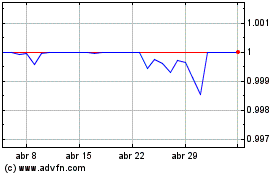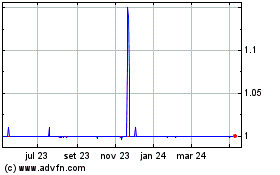What is USDT? All About Tether Stablecoin Cryptocurrency
19 Outubro 2023 - 4:52PM
NEWSBTC
USDT, also known as Tether, has become an integral part of
cryptocurrency markets since its launch in 2014. Pegged 1:1 to the
US dollar, it is the most widely used stablecoin with a market
capitalization of over $83 billion as of October 2023. But it is
also controversial, with opaque reserves and questions around its
long-term viability. Here is an in-depth look at how USDT works,
its importance in crypto, and the risks it presents. What is USDT?
Overview of Tether Stablecoin Cryptocurrency At its core, Tether
functions as a stablecoin, meaning each token is backed by an
equivalent amount of traditional fiat currency. This peg to the
dollar aims to minimize volatility compared to other
cryptocurrencies like Bitcoin and Ethereum. USDT operates on
different blockchains like Bitcoin, Ethereum, Tron and others,
allowing it to be transferred seamlessly between different
networks. Crypto traders rely on USDT as a stable store of value
when trading between different digital assets. It is also widely
used on decentralized finance (DeFi) platforms for lending,
borrowing, and making payments. USDT price: $1 USDT Market Cap:
~$83 billion (as of October 2023) Key Features of USDT Crypto The
key features that define Tether include: Pegged 1:1 to the US
dollar – USDT aims to maintain parity with the dollar Operates on
different blockchains – Enables transfer between networks Hedges
against crypto volatility – Acts as a stable haven when markets are
fluctuating Wide adoption – Used extensively in crypto trading and
DeFi protocols How Does USDT Maintain Its Dollar Peg? According to
Tether Limited, the company behind USDT, every token in circulation
is backed 1:1 by their reserves, which include both traditional
currency and cash equivalents. When buyers purchase USDT by
depositing $1 per token, new tokens are issued while the dollars
are held in reserves. This mechanism theoretically allows users to
redeem each USDT to USD. By allowing two-way convertibility between
USDT and dollars, the supply can adjust to maintain the 1:1 parity.
However, Tether’s reserves have been shrouded in secrecy over the
years, leading to allegations that the company does not hold
sufficient dollar reserves to back all USDT in circulation. Tether
settled a case with the New York Attorney General in 2021, agreeing
to release periodic reports on its reserves. So far, the
redemptions have generally maintained the dollar peg. But questions
linger over the breakdown of reserves and their adequacy as USDT
supply has ballooned. USDT Price Chart from CoinMarketCap The Role
and Importance of USDT in Crypto Despite the opacity, USDT
continues to play a hugely important role in cryptocurrency
markets. It is one of the most widely traded crypto assets, with
daily trading volumes in the billions of dollars against assets
like Bitcoin. Exchanges rely on stablecoin trading pairs like
BTC/USDT to enable traders to hedge risk during times of high
volatility. USDT is also widely integrated into DeFi protocols like
lending and borrowing platforms, decentralized exchanges, yield
farms, and more. It provides stability in an otherwise volatile
environment for decentralized finance. The demand for USDT trading,
transactions, and parking value in a stable asset continues to
drive increasing adoption. Future Outlook for Tether Stablecoin
Going forward, the biggest threat to USDT is the risk of losing its
1:1 dollar peg and collapsing in value if its reserves are
inadequate. Tether also faces potential regulatory crackdowns from
authorities who may threaten its viability. Competing stablecoins
like USDC and BUSD are more transparent about reserves and could
gain share. However, USDT retains first-mover advantage and the
network effects of wider integration in crypto infrastructure. It
continues to maintain peg stability through redemptions so far. If
Tether can provide greater transparency and embrace compliance,
USDT may retain its dominant position for some time. But traders
should exercise caution and understand the risks of relying too
much on USDT long-term. Despite controversies around reserves and
regulation, Tether remains an integral cog in the crypto economy
machine. But as the market matures, stablecoins built on greater
transparency and compliance are likely to emerge as leaders. How
Does USDT Work? There are a few key mechanisms that enable USDT to
function as a stablecoin pegged to the US dollar: Minting and
Issuing New USDT Tether mints new USDT when buyers deposit $1 per
token with the company. The dollars are added to reserves, while an
equivalent amount of USDT is issued on the blockchain ledger. This
USDT enters circulation when transferred to the buyer’s wallet
address. The minting helps adjust supply to match demand. Sending
and Receiving USDT Transactions Once issued, USDT can be transacted
between addresses on its supported blockchains like any other
cryptocurrency. Senders can broadcast transactions and pay small
network fees to send USDT to recipients’ wallet addresses. These
peer-to-peer transactions are recorded transparently on public
blockchain explorers. Trading USDT on Exchanges and DeFi USDT is
listed as a trading pair on most major centralized crypto exchanges
as well as decentralized exchanges. Traders can use USDT to buy and
sell other cryptos like Bitcoin in a stable manner when volatility
is high. In decentralized finance, USDT also serves as a stable
currency for lending, borrowing, liquidity provision, and more.
Redeeming USDT for Dollars In theory, USDT holders can redeem each
token for exactly 1 US dollar from Tether Limited. This is made
possible by the underlying reserves that back each token.
Redemptions help maintain the 1:1 peg when USDT falls below $1 on
exchanges. However, Tether reserves the right to delay or deny
redemptions in some circumstances. Pros and Cons of USDT Stablecoin
USDT provides stability amid crypto volatility but also carries
risks: Pros Avoid volatility by parking value in USDT Seamless
transfers between blockchains Wide acceptance in crypto ecosystem
Useful for decentralized trading and finance Cons Opaque reserves
raise viability concerns Regulatory crackdowns could threaten
operations Reliant on Tether’s redemption policy to maintain peg
Vulnerable to bank runs if reserves are inadequate Tether pioneered
stablecoins in crypto but transparent alternatives like USDC are
emerging. Regulatory direction will play a key role in determining
whether USDT maintains dominance long-term. In conclusion, USDT
remains indispensable for crypto trading and finance today. But
prudent users should assess risks of relying extensively on USDT if
its opaque operations and reserves raise too many questions about
its sustainability. As the sector develops, the stability and
transparency offered by its competitors could make them a safer bet
over the coming years USDT FAQ: Tether Frequently Asked Questions
& Answers What is USDT TRC20? USDT TRC20 is the version of
Tether stablecoin issued on the Tron blockchain as a TRC20 token.
It allows faster transactions and lower fees compared to USDT on
Ethereum. USDT ERC20 is available only on Ethereum. What does USDT
mean? USDT stands for United States Dollar Tether. It is a
cryptocurrency issued by Tether that is pegged 1:1 to the US
dollar. Each USDT token is backed by $1 in reserves according to
Tether Limited. What is the difference between USDC and USDT? USDC
is issued by Circle while USDT is issued by Tether. USDC has
greater transparency on reserves and audits compared to the more
opaque USDT. However, USDT currently has wider adoption in crypto
trading and DeFi applications. What is Tether USDT? Tether USDT is
a stablecoin cryptocurrency whose value is pegged to the US dollar
on a 1:1 basis. It allows crypto traders and users to avoid
volatility by storing value in USDT tokens backed by equivalent USD
reserves. What does USDT stand for? USDT stands for United States
Dollar Tether. It is the ticker symbol used to designate the Tether
stablecoin whose value is pegged to the US dollar. Is USDT a
cryptocurrency? Yes, USDT is a cryptocurrency token issued on
various blockchains. However, unlike volatile cryptos, USDT is a
stablecoin designed to have a stable value through US dollar
reserves. What is the USDT token contract address? The USDT token
address allows users to verify USDT transactions on block
explorers. For example, the USDT Ethereum contract address is
0xdac17f958d2ee523a2206206994597c13d831ec7. What is the current
price of USDT? The price of USDT is pegged to $1.00 USD. It aims to
maintain parity with the dollar through Tether Limited’s dollar
reserves that back each USDT token 1:1. What is USDT crypto used
for? USDT provides stability versus volatile crypto assets. It is
used for trading, payments, earning yield, loans, and other
financial activities where dollar-pegged stability is preferred.
Where can I buy USDT coins? USDT can be purchased on most major
crypto exchanges like Binance, Coinbase, Kraken, KuCoin etc. You
can trade dollars or cryptos like BTC for USDT tokens on these
centralized platforms. Is it safe to invest in USDT stablecoin?
USDT does carry risks related to transparency and reserves that
should be considered. Stablecoins like USDC with more transparency
could potentially be safer long-term investments.
Tether USD (COIN:USDTUSD)
Gráfico Histórico do Ativo
De Jun 2024 até Jul 2024

Tether USD (COIN:USDTUSD)
Gráfico Histórico do Ativo
De Jul 2023 até Jul 2024
